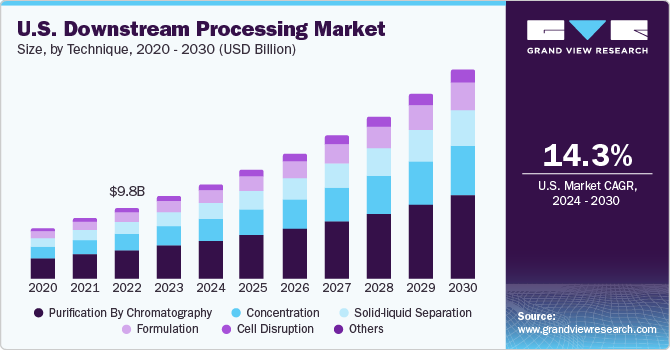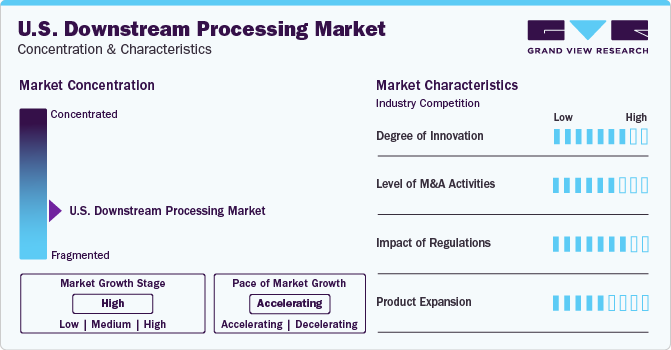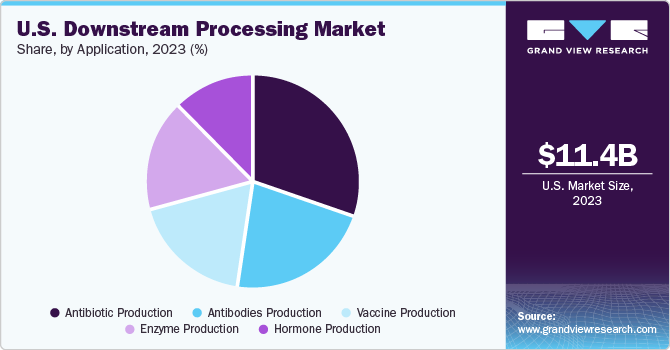- Home
- »
- Biotechnology
- »
-
U.S. Downstream Processing Market, Industry Report, 2030GVR Report cover
![U.S. Downstream Processing Market Size, Share & Trends Report]()
U.S. Downstream Processing Market (2024 - 2030) Size, Share & Trends Analysis Report By Product (Chromatography Systems, Filters), By Technique (Cell Disruption, Formulation), By Application (Antibiotic Production), And Segment Forecasts
- Report ID: GVR-4-68040-238-2
- Number of Report Pages: 80
- Format: PDF
- Historical Range: 2018 - 2023
- Forecast Period: 2024 - 2030
- Industry: Healthcare
- Report Summary
- Table of Contents
- Segmentation
- Methodology
- Download FREE Sample
-
Download Sample Report
U.S. Downstream Processing Market Trends
The U.S. downstream processing market size was estimated at USD 11.35 billion in 2023 and is expected to grow at a CAGR of 14.3% from 2024 to 2030. Major players are focused on streamlining the downstream process and reducing the overall cost of the procedure and the product. Downstream technology is increasingly used in laboratory and industrial-scale applications owing to the growing demand for biologics, which is expected to boost market growth.

The market in the U.S. is expected to grow significantly shortly, owing to the increasing adoption of bioprocessing and biotechnology techniques within the country. The commercial production and sale of products obtained from or used in new biotechnology techniques is relatively recent. Some of the notable products include Amgen's Blincyto and Novartis's Zarxio, the first FDA-approved biosimilar in the U.S. There has been a substantial rise in the sales of biotechnology products within the country owing to recent advancements, and it is expected that there will be a 10-fold increase in the sales in the coming decade.
The global downstream processing market witnessed the U.S. accounting for over 32% of its revenue share in 2023. Thanks to the biotechnology sector's continuous innovation, the market is expected to experience substantial growth opportunities throughout the forecast period. Moreover, the biopharmaceutical sector is considered the most R&D-intensive in the U.S. Biopharmaceuticals development is recognized as a high impact rendering driver to influence the adoption of downstream processing technologies in the coming years. Manufacturing entities such as Corning Life Sciences are constantly developing new technologies and products to reduce the intricacy of their bioproduction processes. Such initiatives are opportunistic for market growth.
Market Concentration & Characteristics
The industry growth stage is high, and the pace of the growth depicts an accelerating trend. The U.S. downstream processing industry is moderately fragmented, which is marked by the presence of many companies competing for a higher revenue share. The industry is in a high growth stage and will continue its trajectory in the coming 5-6 years.

Biopharmaceuticals is one of the major sectors concerning growth prospects. Moreover, companies are undertaking several initiatives for the advancement of this sector to meet surging demand for bio-based pharmaceuticals. This is expected to influence the number of biopharmaceuticals available for clinical use. Many major pharmaceutical companies are shifting their business operations to the biopharma industry. This healthy outlook of biopharmaceuticals has resulted in many biopharmaceuticals in pipelines. Several entities are undertaking various initiatives to convert their bioprocessing unit into a single-use unit owing to the increased efficiency of disposables in accelerating the production of biopharmaceuticals.
The U.S. downstream processing industry is characterized by a significant level of M&A and collaboration activities undertaken by key manufacturers. Numerous players in the country are collaborating with other relevant companies to strengthen their portfolios and expand their reach. For instance, in January 2021, Sartorius Stedim Biotech announced the acquisition of Novasep’s chromatography equipment business. This initiative was aimed at supporting Sartorius in developing advanced chromatography systems to overcome efficiency concerns and bottlenecks around downstream processing.
Government initiatives for advancements in biotechnology are expected to drive the demand for downstream bioprocessing. Studies suggest that nearly 50% of the CMOs and manufacturers need help in hiring the right bioprocess associates to carry out the production process. Several training programs are offered by the government, academic institutions, and industry participants to overcome this situation. A few examples of these include the National Institute for Bioprocessing Research & Training (NIBRT) in Ireland, the Biomanufacturing Training and Education Center (BTEC), and North Carolina State University. Such initiatives are opportunistic for industry growth.
Product Insights
The chromatography systems segment accounted for the largest revenue share of 41.2% in 2023. Chromatography systems include a wide range of products such as chromatography membranes, resins, cleaning-in-place solutions, buffers, and compatible hardware, including single-use systems, multi-use systems, and columns. These products are assembled to form a system used during the DSP purification step. Major market players offer safe, integrated chromatography solutions that work efficiently during all the steps, from process development to production scale. In recent years, key players have developed technologically efficient chromatography systems to address the growing need of pharmaceutical manufacturers. For instance, single-use chromatography represents one of the most significant inventions in the biopharmaceutical industry.
The filters segment is expected to register the fastest CAGR from 2024 to 2030. Harvesting of biological products from large cultures largely depends on filtration, as biomolecules are extremely sensitive to heat and chemical treatments. This eliminates the use of alternative methods for biopharmaceutical filtration. Major types of filters used during a DSP include depth filters, absolute filters, rotary drum vacuum filters, and membrane filters. Filter manufacturers have developed advanced filters with high capacity and performance owing to increased demand for viral clearance and cell densities & titers. Filtration is particularly essential in viral safety as a virus can considerably impact an entire process.
Technique Insights
The purification by chromatography segment held the largest revenue share of 41.6% in 2023. Chromatography is an essential step during the isolation and purification of most of the high-value products. The technique is useful, especially during the DSP of proteins. Chromatography is a major technique that can be employed at all levels of DSP from the first capture to the final step. The most used chromatographic techniques during a DSP include ion exchange chromatography, hydrophobic interaction chromatography, affinity chromatography, and gel filtration chromatography.
Solid-liquid separation is expected to witness the fastest CAGR during the forecast period. Solid-liquid separation refers to the initial stages of product recovery in which whole cells and insoluble ingredients are separated from culture broth that contains the desired products. Major techniques used for solid-liquid separation include flotation, flocculation, filtration, centrifugation, or a combination of these. However, on a production scale, large centrifuges and micro filters are used for separation. The microfiltration technique is the preferred method for the separation of cell debris from the medium. In microfiltration, the mixture is allowed to pass through membranes with pores ranging from 0.1 to 0.8 microns in diameter, depending upon the type of cells present in the process medium.
Application Insights
The antibiotic production segment generated the largest revenue share of 30.1% in 2023. Antibiotics are used to treat several conditions, from cancers to infectious diseases. β-lactam antibiotics, especially cephalosporin and penicillin, are among the most commercialized antibiotics worldwide. Natural cephalosporin and penicillin are manufactured on an industrial scale through bioprocessing techniques and are harvested through downstream processing. With the growing incidence of antibiotic resistance, the demand for developing antibodies against resistant strains has increased. This, in turn, is likely to drive the demand for bioprocessing technologies for antibody production at an industrial scale and will boost market growth during the forecast period.

Antibodies production is expected to grow at the fastest CAGR during the forecast period. Monoclonal antibodies are used for various clinical indications such as cancers, inflammatory disorders, and infectious diseases. These products are one of the most predominant modalities the biopharmaceutical industry offers today. This can be attributed to establishing robust manufacturing platforms that produce high titers for monoclonal antibodies in mammalian cell cultures. In addition, the evolution of certain new methods in the bioprocessing of antibodies has further propelled the market growth as they have led to an evolution in process platform approaches.
Key U.S. Downstream Processing Company Insights
Key U.S. downstream processing companies include Danaher Corporation, GE Healthcare, and Thermo Fisher Scientific Inc. among others. Companies are expanding their global footprint by establishing collaborations, partnerships, and acquisitions to tap in new markets and countries. Collaborations with healthcare providers and research institutions, such as the Mayo Clinic and academic medical centers, are opportunistic to access expertise and assess their technologies.
Key U.S. Downstream Processing Companies:
- Merck KGaA
- Sartorius Stedim Biotech S.A
- GE Healthcare
- Thermo Fisher Scientific Inc.
- Danaher Corporation
- Repligen
- 3M Company
- Boehringer Ingelheim International GmbH
- Corning Corporation
- Lonza Group Ltd
- Dover Corporation
- Ashai Kasei
- Ferner PLC
- Eppendorf AG
Recent Developments
-
In January 2023, Sartorious entered a strategic collaboration with RoosterBio Inc. for enhancing its exosome-based therapies’ downstream purification processes.
-
In March 2022, Rentschler Biopharma along with Vetter unveiled the launch of Xpert Alliance. The alliance is purposed to support the companies to deliver advanced solutions to customers' challenging demands in the field of biopharmaceuticals.
-
In February 2022, Sartorius announced the acquisition of Novasep's chromatography business. The portfolio comprises chromatography systems developed especially for smaller biomolecules including peptides, insulin, and oligonucleotides, as well as new technologies for continuous production of biologics.
U.S. Downstream Processing Market Report Scope
Report Attribute
Details
Revenue forecast in 2030
USD 28.95 billion
Growth Rate
CAGR of 14.3% from 2024 to 2030
Actual data
2018 - 2023
Forecast period
2024 - 2030
Quantitative units
Revenue in USD million/billion, and CAGR from 2024 to 2030
Report coverage
Revenue forecast, company ranking, competitive landscape, growth factors, and trends, product outlook
Segments covered
Product, technique, application
Country Scope
U.S.
Key companies profiled
Merck KGaA; Sartorius Stedim Biotech S.A; GE Healthcare; Thermo Fisher Scientific Inc.; Danaher Corporation; Repligen; 3M Company; Boehringer Ingelheim International GmbH; Corning Corporation; Lonza Group Ltd; Dover Corporation; Ashai Kasei; Ferner PLC; Eppendorf AG
Customization scope
Free report customization (equivalent up to 8 analysts working days) with purchase. Addition or alteration to country, & segment scope.
Pricing and purchase options
Avail customized purchase options to meet your exact research needs. Explore purchase options
U.S. Downstream Processing Market Report Segmentation
This report forecasts revenue growth in the U.S. market and provides an analysis of the latest industry trends in each of the sub-segments from 2018 to 2030. For this study, Grand View Research has segmented the U.S. downstream processing market report based on product, technique, and application:
-
Product Outlook (Revenue, USD Billion, 2018 - 2030)
-
Chromatography Systems
-
Filters
-
Evaporators
-
Centrifuges
-
Dryers
-
Others
-
-
Technique Outlook (Revenue, USD Billion, 2018 - 2030)
-
Cell Disruption
-
Solid-liquid Separation
-
Filtration
-
Centrifugation
-
-
Concentration
-
Evaporation
-
Membrane Filtration
-
-
Purification By Chromatography
-
Formulation
-
-
Application Outlook (Revenue, USD Billion, 2018 - 2030)
-
Antibiotic Production
-
Hormone Production
-
Antibodies Production
-
Enzyme Production
-
Vaccine Production
-
Frequently Asked Questions About This Report
b. The U.S. downstream processing market size was estimated at USD 11.35 billion in 2023
b. The U.S. downstream processing market is expected to grow at a compound annual growth rate of 14.3% from 2024 to 2030 to reach USD 28.95 billion by 2030.
b. Based on product, the chromatography systems segment accounted for the largest revenue share of 41.2% in 2023.
b. Some of the key players in the market are Merck KGaA; Sartorius Stedim Biotech S.A; GE Healthcare; Thermo Fisher Scientific Inc.; Danaher Corporation; Repligen; 3M Company; Boehringer Ingelheim International GmbH; Corning Corporation; Lonza Group Ltd; Dover Corporation; Ashai Kasei; Ferner PLC; and Eppendorf AG
b. Some of the key factors driving the market include commercial success of biopharmaceuticals boosts demand for innovation in bioprocessing, rising adoption of single-use technology in bioprocessing, and expansion of bioprocessing capacity.
Share this report with your colleague or friend.
Need a Tailored Report?
Customize this report to your needs — add regions, segments, or data points, with 20% free customization.

ISO 9001:2015 & 27001:2022 Certified
We are GDPR and CCPA compliant! Your transaction & personal information is safe and secure. For more details, please read our privacy policy.
Trusted market insights - try a free sample
See how our reports are structured and why industry leaders rely on Grand View Research. Get a free sample or ask us to tailor this report to your needs.










